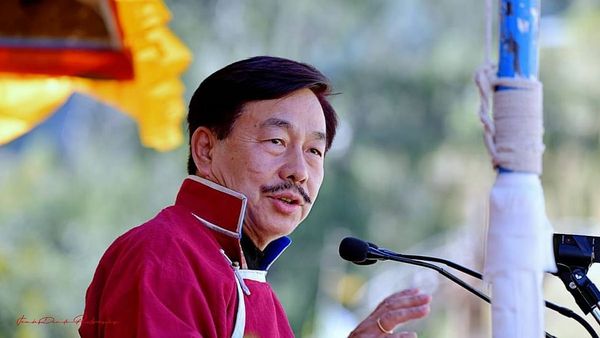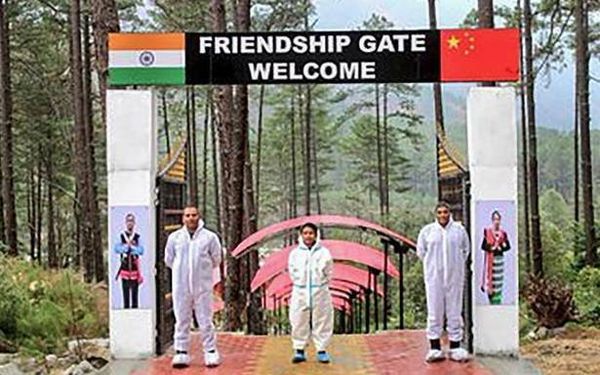After the 1962 Sino-India War was over, the Indian Army was confronted with the problem of bodies of around 190 Indian soldiers lying in areas around 8 kilometres to 16 kilometres inside the Chinese 1960 claim line in Ladakh. Collecting the bodies of the fallen soldiers after the war through mutual consent is an established military practice, and the Indian Red Cross wrote to its Chinese counterpart in April 1963. The Chinese turned down the request, stating that the bodies had been properly buried, and there was no need to send any Indian parties into disputed areas. As most Indian soldiers were to be cremated, not buried, the issue was again taken up with the Chinese. In August, the Chinese agreed to carry out the cremation and hand over the ashes to the Indian Red Cross.
When the Indian Red Cross requested that Indian representatives be present during the ceremony, the Chinese cancelled the arrangements altogether. In its memo on September 16, 1963, the Chinese Foreign Ministry accused the Indian government of trying to lay claim to these territories through this device.
India announces diplomatic boycott of Beijing Winter Olympics
While cancelling these arrangements, the Chinese Foreign Ministry insisted that the Indians who died at their posts in Ladakh were ‘invaders’ and not defending their ‘motherland’. Earlier, after overcoming the stiff Indian resistance at Rezang La, memorialised in the Hindi film, Haqeeqat, and at Gurung Hill, the People’s Liberation Army (PLA) had buried the bodies of five Indian soldiers — wooden posts with the inscriptions in Chinese and English, ‘The Corpses of Indian Invaders’. The purpose of the elaborate exercise was to deny any legitimate Indian presence and claim over these areas in future negotiations. If Indian soldiers had died defending their motherland, then it was an area in Indian possession and control — that would belie the Chinese claim over the territories in Ladakh. Its efforts to create facts on the ground to bolster its ‘historical’ claim underline the extent of Chinese enterprise in asserting its territorial claims.
Delinking Depsang
It thus comes as a surprise that in a recent television interview, the Indian Army Chief, General M.M. Naravane, argued that “out of the five or six friction points (in Ladakh), five have been solved”. ‘Friction point’ is an Indian euphemism for points of Chinese ingress into hitherto India-controlled territory in Ladakh, where this control is exercised by the Army and the Indo-Tibetan Border Police (ITBP) through regular patrols to the claimed areas. These ‘friction points’ are Depsang, Galwan, Hot Springs, Gogra, North bank of Pangong Tso, Kailash Range and Demchok. By asserting that only one of the friction points is remaining to be resolved — he was referring to Hot Springs or PP15, the only one discussed in the last round of talks with the Chinese — he implicitly ruled out Depsang as an area to be resolved. This attempt to delink the strategically important area of Depsang from the ongoing Ladakh border crisis is worrying. It may suit the domestic political agenda of the Narendra Modi government of proclaiming an early end to the crisis, but it has long-term strategic consequences for India.
Depsang is an enclave of flat terrain located in an area the Army classifies as Sub-Sector North (SSN), which provides land access to Central Asia through the Karakoram Pass. A few kilometres south-east from the important airstrip of Daulat Beg Oldi (DBO), the Chinese army has blocked Indian patrols since early 2020 at a place called Y-junction or Bottleneck, denying it access to five PPs: PP10, PP11, PP11A, PP12 and PP13. A joint patrol of the ITBP and Army would patrol these five PPs approximately once a month. Y-junction is around 18 km on the Indian side of the Line of Actual Control, even though the Chinese claim line lies another five kilometres further west, to the east of Burtse town. Satellite imagery from November 2021 confirms Chinese deployments at the Y-junction: two PLA Ground Force camps with six infantry fighting vehicles split between two positions while a small Indian Army forward camp is stationed 1.2 km west of the Y-junction.
Amid chill in relations, new PLA history returns spotlight to 1962 war
Stand-off in 2013 and patrols
The Indian forward camp is the new patrol base, with a permanent patrol deployed there, that was created after a 22-day long stand-off at Y-junction in April 2013. Since then, it has observed and stopped Chinese patrols from moving further to the Indian side, but a PLA patrol had still managed to get up to around 1.5 km short of Burtse in September 2015. Essentially, till the current blockade, the Indian side was able to access the five patrolling points, asserting Indian control, while the PLA had been denied access to its claim line since the late 2000s. That status quo has been disturbed since early 2020.
Since the Ladakh border crisis came to light in May 2020, a section of the security establishment has tried to bury any conversation about Depsang. Media reports attributable to ‘sources’ have labelled it a ‘legacy issue,’ suggesting that the crisis has continued since April 2013. The 2013 stand-off was resolved diplomatically after negotiations led to reversal of an Indian ingress and bunker construction on the Chinese side in Chumar, while the PLA stepped away from the Y-junction. Lt. Gen. K.T. Parnaik (retd.), the then Northern Army Commander, has confirmed “resort(ing) to a quid pro quo, as we did during the Depsang intrusion in 2013. Early response creates leverage.”
Galwan clash | China suffered higher losses than reported, says Australian newspaper
Former Ladakh Corps Commander Lt. Gen. Rakesh Sharma (retd.) was categorical in asserting that “patrolling had continued, as planned, since [the] April/May 2013 stand-off” and “to now state that we were not able to reach our LOP since 2013 as [the] PLA was blocking our movement, is pure heresy”. The fact that specific major general-level talks for Depsang were held with the Chinese on August 8, 2020 proves that it is part of the ongoing crisis. A 22-day stand-off in 2013 generated much public and media outrage but a 22-month long blockade of patrolling rights in the same area now has been greeted with silence.
Depsang’s importance
The Army has always identified Depsang plains as where it finds itself most vulnerable in Ladakh, devising plans to tackle the major Chinese challenge. SSN’s flat terrain of Depsang, Trig Heights and DBO — which provides direct access to Aksai Chin — is suited for mechanised warfare but is located at the end of only one very long and tenuous communication axis for India. China, in turn, has multiple roads that provide easy access to the area. This leaves SSN highly vulnerable to capture by the PLA, with a few thousands of square kilometres from the Karakoram Pass to Burtse, likely to be lost. Nowhere else in Ladakh is the PLA likely to gain so much territory in a single swoop.
SSN lies to the east of Siachen, located between the Saltoro ridge on the Pakistani border and the Saser ridge close to the Chinese border. On paper, it is the only place where a physical military collusion can take place between Pakistan and China — and the challenge of a two-front war can become real in the worst-case scenario. If India loses this area, it will be nearly impossible to launch a military operation to wrest back Gilgit-Baltistan from Pakistan.
India, China agree for more LAC talks
Theoretically, Depsang is also seen as a viable launchpad for a mechanised force-based military offensive launched by India inside Aksai Chin, if the Army has to fulfil Union Home Minister Amit Shah’s parliamentary vow of getting back Aksai Chin from China.
Danger of delinking
The biggest danger of delinking Depsang from the current border crisis in Ladakh, however, is of corroborating the Chinese argument, which invalidates the rightful Indian claim over a large swathe of territory. In sparsely populated areas like Ladakh, with limited forward deployment of troops, the only assertion of territorial claims is by regular patrolling. By arguing that the blockade at Y-junction predates the current stand-off — a ‘legacy issue’ that goes back years — the Chinese side can affirm that Indian patrols never had access to this area and thus India has no valid claim on the territory. Already living with the disadvantage of being a lesser power vis-à-vis China, this argument further weakens India’s hand during negotiations in Ladakh.
Not for third party in LAC talks, China tells U.S.
This will be akin to Prime Minister Narendra Modi’s statement during the all-party meeting in June 2020 that no one had entered Indian territory, which ended up bolstering Chinese position during the talks. India cannot afford to repeat that blunder again and lose its land. As was demonstrated by China in the aftermath of the 1962 War, there should be no holding back in painstakingly asserting one’s claims when it comes to safeguarding the territory. Denial of truth for domestic political gains, in this case, will certainly be to the detriment of India’s strategic interests.
Sushant Singh is Senior Fellow at the Centre for Policy Research










